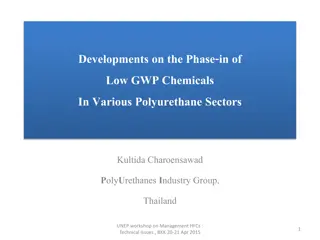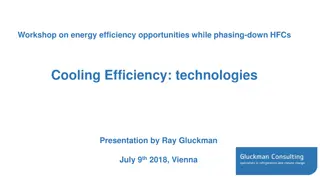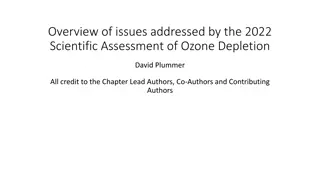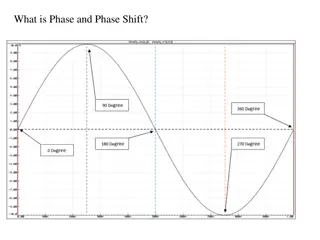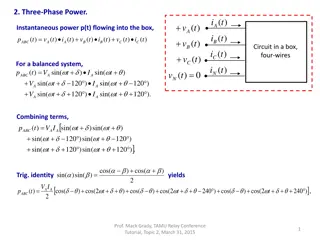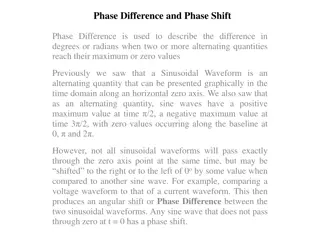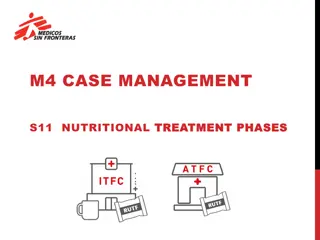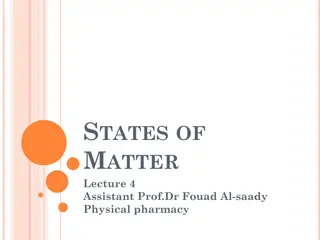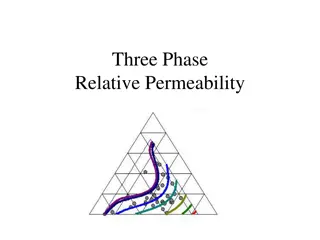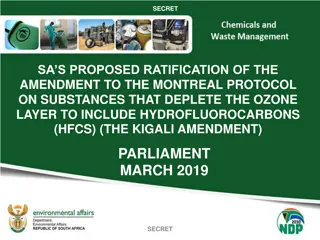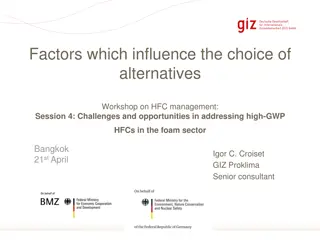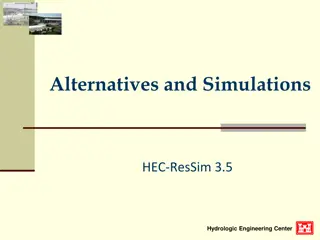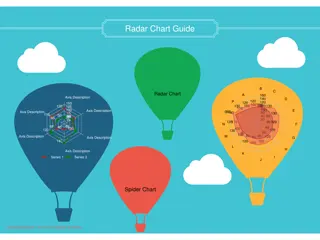Importance of NIK Alternatives in Phase Down of HFCs
NIK alternatives play a crucial role in phasing down high GWP HFCs, with a focus on next-generation solutions like HFOs and HFO/HFC blends. These alternatives have zero ODP and low GWP, making them effective replacements for various sectors. Regulations in the EU, US, Japan, and Canada are driving the shift towards NIK alternatives, offering opportunities for significant HFC replacement. Various NIK options such as blowing agents, refrigerants, extinguishing agents, and metered dose inhalers are available to replace fluorinated alternatives, contributing to emission reductions and sustainability goals.
Download Presentation

Please find below an Image/Link to download the presentation.
The content on the website is provided AS IS for your information and personal use only. It may not be sold, licensed, or shared on other websites without obtaining consent from the author. Download presentation by click this link. If you encounter any issues during the download, it is possible that the publisher has removed the file from their server.
E N D
Presentation Transcript
Importance of NIK Alternatives to Phase Down of High GWP HFCs Steve Seidel and Jason Ye (C2ES), Stephen O. Andersen (IGSD), and Alex Hillbrand (NRDC) 28thMeeting of the Parties Kigali, Rwanda October 10, 2016
Role of Not-in-Kind (NIKs) Overview Alternatives to replace high GWP hydrofluorocarbons (HFCs) already exist and more are being developed Focus has been on next generation hydrofluoroolefins (HFOs) and HFO/HFC blends HFOs have zero ODP and ultra low GWP (less than 1) HFO/HFC blends have zero ODP and low GWP depending on portion of ingredients NIK alternatives have played a major role in past ODS phase-outs NIK alternatives are widely available to replace HFCs for many sectors HFC regulations in EU, US, Japan and Canada are driving shift away from HFCs Near-term options exist that avoid patent protected HFOs Opportunities exist for up to 50 percent replacement of HFCs with NIKs
What are NIKs? Generally refers to alternatives that are not fluorinated Wide range of NIKs available including: Blowing agents: hydrocarbon, water and carbon dioxide Refrigerants: ammonia, carbon dioxide and hydrocarbon Extinguishing agents: water, water mist, dry powder, and foam Metered dose inhalers: dry-powder inhalers (DPIs), oral and injectable drugs Emission (leak) reductions and recycling/recovery also contribute to reductions Estimated that transition out of ODS replaced 85 percent of use with NIKs or through emission reductions/recovery
Projected Growth in HFCs Without an HFC amendment, consumption grows significantly Past growth in developed countries quickly outpaced by growth in developing countries By 2050, 80 percent of HFC use in developing countries
HFC Use by Sector Current use of HFCs concentrated in air conditioning (56%) and refrigeration (30%) sectors; foam a distant third (7%); aerosol products/fire protection a distant fourth/fifth (4%/3%); and solvents just 1% Analysis focuses on these three sectors
Refrigeration Sector Includes domestic, commercial, industrial and transport subsectors Projected to grow at 6 percent annually Commercial refrigeration largest subsector
Refrigeration Sector Fluorocarbon Alternatives NIKs Comments Domestic HFO-1234yf HFO 1234ze Hydrocarbons Hydrocarbon blends HFOs are being considered. HC systems widely used. Commercial HFO-1234yf HFO-1234ze HFO/HFC blends Hydrocarbons Ammonia Carbon dioxide HFO/HFC blends are growing in use; HCs widely used in systems with smaller charges; carbon dioxide growing in use in commercial systems. Industrial HFO-1233zd HFO-1336mzz HFO-1234ze HFO/HFC blends Hydrocarbons Ammonia Carbon dioxide HFOs and blends increasing in use. Ammonia widely used for large systems; Ammonia used for cold stores. Transport HFO/HFC blends Hydrocarbons Carbon dioxide HFO/HFC blends in limited use; HC and carbon dioxide systems being developed.
Air Conditioning Sector Includes stationary, chillers and mobile Projected growth of 4.5 percent annually Stationary is largest subsector
Air Conditioning Sector Fluorocarbon Alternatives NIK Alternatives Comments Stationary AC HFO-1234yf HFO-1234ze HFO-12336mzz HFC-32 HFO/HFC blends Hydrocarbons Ammonia Water Carbon dioxide Systems with smaller charges are widely available using HFC-32 and hydrocarbons; HFC-HFO blends developed for larger systems. Chillers HFO-1233zd HFO- 1336mzz HFO-1234ze HFO/HFC blends Hydrocarbons Ammonia Water Hydrocarbons used for medium and large chillers; HFOs and blends being developed for small and medium-size systems. Mobile AC HFO-1234yf HFC-152a HFO/HFC blends Carbon dioxide HFP1234yf widely used; Carbon dioxide being commercialized by two companies for some models; HFC-152a being tested in secondary loop.
Foam Sector Includes polyurethane (PU) and extruded polystyrene (XPS) foams Projected decline of 2.2growth percent annually XPS is largest subsector Hydrocarbons widely used, making up more than half of consumption in this sector
Foam Sector Fluorocarbon Alternatives HFO-1336mzz HFO-1234ze HFO-1233zd NIKs Comments PU CO2 CO2with co- blowing agent Supercritical CO2 Most HFOs are commercially available; HFO-1336mzz expected in 2017. CO2is available and widely used; Supercritical CO2used only in Japan. Commercially available; used in Europe. XPS HFO-1234ze CO2
NIK Substitution Opportunities Sectors contribute the following potentials for NIK solutions: High (70 percent): domestic refrigeration, industrial refrigeration, commercial refrigeration, and fire protection Medium (50 percent): aerosols and foams Low (20 percent): heating heat pumps, chillers, MAC, stationary AC, and transportation refrigeration
Emerging Technology Can Expand NIK Use Appropriate charge limits/safety standards for flammable refrigerants Smaller flammable charge and better containment System design to slow worst-case refrigerant discharge Isolate flammable and toxic refrigerants with secondary loop of non- flammable coolant to occupied spaces Active safety systems Non-fluorinated low-GWP refrigerant ingredients to reduce flammability of natural refrigerants
Key Takeaways (1) In the absence of an HFC phase-down amendment, HFC growth in A5 Parties would continue with more than 80 percent of use of HFCs in Article 5 Parties in 2050 In response to domestic regulations by non-A5 Parties, alternatives to high-global GWP HFCs have been developed and are being used in all major use sectors In most sectors a range of options exists including next-generation (hydrofluoroolefins HFOs and HFO/HFC blends), lower-GWP HFCs, HCs and other non-fluorocarbon refrigerants and foam blowing agents
Key Takeaways (2) In past transitions, NIK alternatives including substitutes other than fluorocarbons (e.g., HCs, CO2), recycling/recovery, and emission reductions have reduced reliance on ODSs by as much 85 percent Based on the current availability of non-fluorinated alternatives and likely emission reductions, NIK alternatives have the potential to be substitutes for 50% of HFCs NIKs and lower-GWP HFCs provide market and price competition to next-generation HFO substitutes which are restricted by patents for a specified period of time Efforts are underway but will require several more years to fully address changes in codes and standards to ensure a wider range of more flammable alternatives can be used safely


